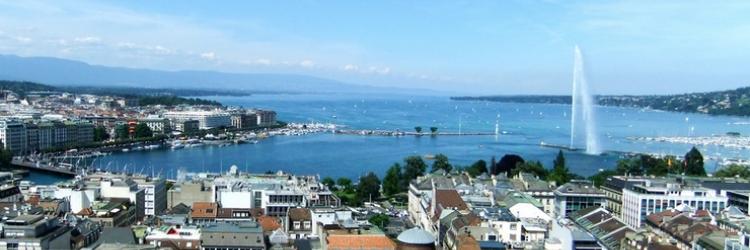Travel destinations Comments: 0 May 29, 2017
Another city that lies on Lake Geneva and in close vicinity of the French border, Geneva offers a taste of cosmopolitan atmosphere and international flavor due to the fact that it is a place of many headquarters for a number of multinational corporations and associations, particularly the headquarters of the United Nations from 1920 to 1946. As the whole city is surrounded by France, except the lake route which connects it with Switzerland, the homogenous mixture of styles is evident in the city’s architecture.
The Old Town rises over the Rhône River which flows from the lake, and its picturesque winding streets and flights of stairs all lead to the cathedral which lies in the very center of the Old Town. The old town is encompassed by a ring of buildings on its three sides which go along the line of Geneva's ancient fortifications. Below the Old Town is the business center , while at the lake shore most of Geneva’s tourist attractions can be found, together with elegant promenades, parks, and gardens.
Temple de Saint-Pierre: Dating back to 1150 as the Cathedral of Saint-Pierre, is one of the oldest construction in Geneva. Lying in the center of the old Town, this Romanesque church adorned with Gothic elements was turned into a protestant church during the Protestant Reformation, in which Geneva played an important role, when its name changed to Temple de Saint-Pierre. Only the carved capitals and the stained glass remain from its original decoration, as John Calvin’s followers removed all the altars and paintings. While the cathedral was built in the 12th century, its two towers, that date from the 13th century, were never finished, but tourists can climb them to enjoy beautiful views over the town and the lake. Archaeological excavations below the church reveal an extensive underground labyrinth from the early Christian settlement on the hill, including Roman mosaics and two 4th-century Christian sanctuaries.
Jet d'Eau (Water Jet): Geneva’s most famous landmark, beside the Jetée des Eaux-Vives, is this mighty jet of water that soars straight up from the lake surface in a 145-meter plume. Thanks to the advanced hydraulics of the powerful pump, the water is propelled at a rate of about 500 liters a second, which accounts for the height it reaches. A good viewpoint is from the Bains des Pâquis, a favorite spot for locals to swim, enjoy a sauna, or have a bite in a café.
Place du Bourg-de-Four: The oldest square lying in the heart of Geneva's Old Town, near the Temple de Saint-Pierre, has a unique charm and atmosphere which attracts visitors from all over the world. While today this square is the place of an important market, in the 16th century the square offered shelter for exiled Protestants. Today, tourists and locals find refuge in its cafés and restaurants, with many of them putting out tables and chairs onto the pavement in good weather. The most famous attractions of the square are its fountain, built in the 18th century, and the statue of Clementine sculpted by Heinz Schwarz, as well as the Palais de Justice, built as a convent in the early 1700s, which has housed the law courts since 1860.
Jardin Anglais (English Garden) and the Mouettes: The hustle and bustle of the booming streets of Geneva can be easily avoided in the Jardin Anglais, set on the southern bank of the lake, famous for its large flower clock, which is almost as emblematic of the city as the Jet d'Eau. The outer appearance of the clock changes with every season, featuring seasonal blooming plants. The garden is also valuable for Geneva’s tourism thanks to the Monument National, with allegorical figures of Helvetia and Geneva, commemorating Geneva's entry into the Swiss Confederation in 1814. Along the south lake shore, in addition to the English Garden, are two parks, the Parc de la Grange, with a beautiful rose-garden, and the Parc des Eaux-Viveswith luscious trees and flower-beds.
Palais des Nations: The large complex of marble buildings that make up the Palais des Nations today houses the European headquarters of the United Nations, and as such is regarded as a center of world diplomacy after UN center in New York, with more than the largest 25,000 delegates passing through annually. Visitors can opt for a guided tourmwhere they can witness and learn about work carried on here and enjoy the artworks and interiors donated by countries worldwide.
Situated in the French-speaking region of Switzerland and surrounded by the Alps and Jura Mountains, this city lying right next to the largest European lake is considered to be a perfect masterpiece, as well as a perfect tourist destination, as Geneva has the shortest commuting time for any city in the world thanks to its efficient transfer. While it is regarded as the most expensive city in the world, it also offers the highest quality of life, for which more than 40% of foreigners have permanently moved here.


 RS
RS  ME
ME  HR
HR  BA
BA  RU
RU  MK
MK  AL
AL  ES
ES  DE
DE  IT
IT  CN
CN  NL
NL  SE
SE  FR
FR 






Write a comment